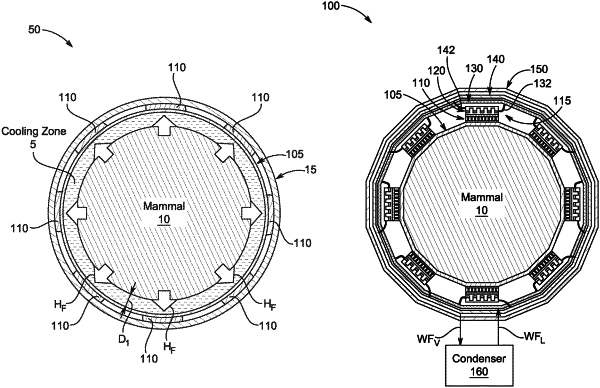| CPC A61F 7/0085 (2013.01) [A61F 7/007 (2013.01); A61F 2007/003 (2013.01); A61F 2007/0009 (2013.01); A61F 2007/0035 (2013.01); A61F 2007/0042 (2013.01); A61F 2007/0044 (2013.01); A61F 2007/0058 (2013.01); A61F 2007/0075 (2013.01)] | 30 Claims |

|
1. A heat transfer device, comprising:
thermoelectric components arranged in an array and spaced apart from each other, wherein individual thermoelectric components have a first side configured to be thermally coupled to a target area of a mammal and a second side opposite the first side;
a heat transfer system comprising—
a heat exchanger,
a common inlet fluid distribution passage fluidically coupled to the heat exchanger,
a common outlet fluid distribution passage fluidically coupled to the heat exchanger, and
fluid distribution networks fluidically coupled in parallel to the common inlet fluid distribution passage and the common outlet fluid distribution passage, wherein—
each of the fluid distribution networks is thermally coupled to the second side of a corresponding one of the thermoelectric components,
each of the fluid distribution networks includes an inlet region fluidically coupled to the common inlet fluid distribution passage, an outlet region fluidically coupled to the common outlet fluid distribution passage, and microfeatures spaced apart from each other along a first axis to at least partially define channels configured to receive a working fluid, and
in operation, the working fluid flows from the inlet region to the outlet region and absorbs heat from the microfeatures,
wherein the microfeatures are spaced apart from corresponding thermoelectric components along a second axis, perpendicular to the first axis, by a first distance and one of the common inlet fluid distribution passage or the common outlet fluid distribution passage is spaced apart from the corresponding thermoelectric components along the second axis by a second distance greater than the first distance, and
wherein a distance between the first side of the individual thermoelectric components and an outermost surface of one of the common inlet fluid distribution passage or the common outlet fluid distribution passage is no more than 30 millimeters; and
a flexible support unit coupled to the first side of the thermoelectric components such that when the flexible support unit is attached to the mammal the thermoelectric components are arranged to be adjacent to the target area.
|